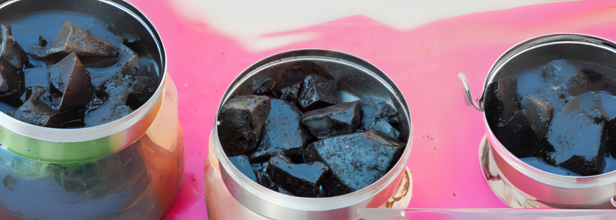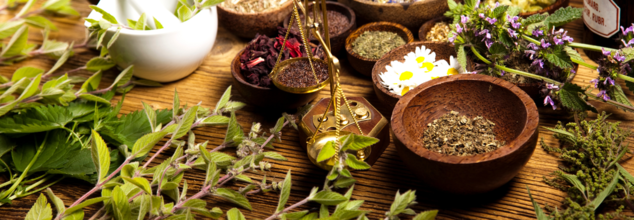- Health Conditions A-Z
- Health & Wellness
- Nutrition
- Fitness
- Health News
- Ayurveda
- Videos
- Medicine A-Z
- Parenting
- Web Stories
Is Shilajit Just for Men, Or Can Women Benefit From This Ayurvedic Supplement Too?

Credits: Canva
Shilajit, a sticky, tar-like mineral compound, is frequently marketed as a vitality booster for men. But does that mean it’s not suitable for women? Ayurveda practitioner Mr. Danny Kumar Meena, Founder & CEO at Girlyveda, says that while the marketing is gendered, the benefits are not.
“Shilajit is a Rasayan, which means it rejuvenates the body,” he says. “It supports strength, stamina, fertility, immunity, and hormonal balance—not just in men, but in women too.”
Hormonal Balance, Menstrual Health & Fertility
Shilajit can be particularly helpful for women facing hormonal imbalances, including conditions like PCOS or irregular menstrual cycles. “It helps balance Vata dosha, which plays a crucial role in regulating the endocrine system,” Mr. Meena explains. “When hormones are in check, menstrual regularity and fertility improve.”
It also enhances Shukra Dhatu, the reproductive tissue responsible for fertility in both men and women. For women, this means improved ovarian function and libido.
“People don’t talk enough about how well it works for female fertility and hormonal health,” Mr. Meena points out.
Menopause, Bone Health & Postpartum Recovery
Post-menopause, many women face a decline in bone density and vitality. Shilajit helps by supporting Asti Dhatu (bone tissue) and enhancing Ojas, the vital essence of the body that governs immunity and vitality.
“It replenishes the seven dhatus (tissues) of the body—blood, muscle, fat, bone, marrow, reproductive tissue, and plasma—making it valuable in postpartum recovery as well,” he says.
Mental Health & Cognitive Benefits
Shilajit has also been described in ancient Ayurvedic texts like Bhav Prakash as a Medhya Rasayan, which means it's beneficial for the brain.
“It helps improve memory, learning, and attention span,” says Mr. Meena. “In today's world of information overload, Shilajit can support focus and mental clarity. It also helps regulate stress by balancing hormone levels, especially cortisol.”
Energy, Digestion & Immunity
Chronic fatigue, low energy, or poor digestion? Shilajit could help. It enhances Bal (strength) and Vyayam Shakti (exercise capacity), and improves Dhatvagni—the refined stage of digestion that ensures nutrients are converted into healthy tissues.
It also boosts immunity by enhancing Ojas. “Shilajit strengthens the body from within,” Mr. Meena notes.
How Should Women Consume It?
Shilajit is hot in potency, so dosage and combinations—called Anupan in Ayurveda—matter greatly.
With cow’s milk: Promotes calm, enhances fertility and rejuvenation
With honey: Fights obesity, balances Kapha
With ghee: Builds immunity (Ojas)
With lukewarm water: Acts as a gentle detoxifier
“The time of day and season matter too. Morning is ideal, but avoid it during summer and autumn (Grishma and Sharad Ritu), when Pitta dosha is naturally high,” Mr. Meena advises.
Caution: Who Should Avoid Shilajit?
Despite its many benefits, Shilajit is not for everyone, especially if taken without supervision.
Avoid if:
- You experience heavy menstrual bleeding or frequent periods
- You are pregnant
- You have bleeding disorders
- You are on long-term medication without medical consultation
“Because of its hot potency, it can cause side effects like burning sensation, constipation, itching, or even nosebleeds—especially in summer,” Mr. Meena warns. “Women with high blood pressure or heart issues should be particularly cautious. While it may help in certain cardiac conditions, it could also worsen palpitations if not used properly.”
Shilajit can be extremely beneficial for women—but only when taken under medical supervision. Its adaptogenic properties, rejuvenative effects, and support for reproductive, mental, and immune health make it a powerful Ayurvedic supplement.
“Ayurveda isn’t about ‘one size fits all’. It’s about using nature mindfully to bring balance to the body. With the right dose, timing, and combination, Shilajit can be as good for women as it is for men,” Mr. Meena concludes.
Note: This article is intended for informational purposes only and is not a substitute for professional medical advice, diagnosis, or treatment. The content does not constitute a recommendation to use Shilajit or any other supplement. Always consult a qualified healthcare provider before making changes to your diet, lifestyle, or supplement routine—especially if you have a pre-existing medical condition or are pregnant, nursing, or on medication.
Shilajit For Wellness Is Rebranding Ancient Healing; Are We Oversimplifying Ayurveda To Make It Aesthetic?

Credits: Health and me
Shilajit, the word rolls off the tongue like a sacred chant—ancient, mysterious, powerful. Just a few years ago, Shilajit was tucked away in apothecary cabinets or Ayurvedic scriptures, today it's repackaged in matte-black jars and glossy Instagram reels, with words like "clean energy," "mood booster," and "longevity hack", hashtagged #BiohackYourLife. It’s being stirred into protein shakes, dropped into morning lattes, and touted as a cure-all on TikTok. But here’s the thing: what happens when an ancient healing system rooted in deep personalisation is flattened into a trendy wellness fix?
Shilajit—a mineral-rich resin that oozes from the Himalayas, Altai, and Caucasus mountain ranges—has been used in Ayurveda for centuries. Packed with fulvic acid, humic compounds, and over 85 trace minerals, it’s traditionally been prescribed as a rasayana: a rejuvenator. But as Shilajit gets pulled into the glossy world of modern wellness, we have to ask: Are we distorting ancient healing systems in our rush to rebrand them as trending lifestyle hacks?
Shilajit’s therapeutic effects are now being studied through a contemporary lens. Fulvic acid enhances mitochondrial energy production—crucial for stamina and recovery. Dibenzo-alpha-pyrones support nervous system health and offer antioxidant properties. It’s no surprise then that today’s nutraceutical brands are racing to bottle it for everything from testosterone enhancement to cognitive support. But here’s where the waters get murky.
Why Ayurveda Might Be Oversimplified?
Ayurveda isn’t just about ingredients. It’s a complex, deeply individualized system rooted in the balance of three doshas—Vata, Pitta, and Kapha—which reflect a person’s constitution. The same herb can be healing for one dosha type and aggravating for another.
When brands market Shilajit as a one-size-fits-all solution, they erase this core nuance. There’s no mention of whether your Pitta might be too high or your Kapha sluggish. No consultation, no customization. Just glossy minimalism dressed in Sanskrit font.
What we’re seeing is a sanitization of Ayurveda. The ritual becomes a product. The lineage becomes a lifestyle brand. And the consumer becomes someone looking for quick fixes rather than holistic healing.
Shilajit isn’t alone. The same thing happened with turmeric (rebranded as "golden milk"), ashwagandha (now sold as "adaptogenic chill"), and ghee (marketed as keto butter). Platforms like TikTok and Instagram flatten the cultural context of these practices, turning them into 30-second aesthetic reels.
And here’s the thing: accessibility is great. The global interest in Ayurveda is exciting. But there’s a thin line between translation and appropriation. When these herbs and rituals are stripped of their philosophy, they become detached—just ingredients in the next wellness cocktail.
Problem With Oversimplification
The Ayurvedic system is deeply personal. Vata, Pitta, and Kapha—these aren’t lifestyle labels; they’re diagnostic tools that determine treatment. The reduction of Ayurveda to a minimalist aesthetic—earth-toned product photography, abstract mandala designs, and simplified “natural = good” messaging—ignores the nuances. More dangerously, it can lead to misuse. Someone with high Pitta may actually worsen their inflammation by using an energetically heating herb like Shilajit.
What the Science Supports — and What It Doesn’t
Studies have backed Shilajit’s efficacy in specific areas:
Energy & Endurance: Fulvic acid supports ATP production, enhancing stamina.
Cognitive Support: Preliminary trials show potential in Alzheimer’s prevention due to its neuroprotective properties.
Reproductive Health: Some studies suggest improved sperm count and testosterone levels.
Skin & Anti-Aging: Antioxidants help with cellular repair and may reduce visible signs of aging.
However, long-term effects, contraindications with medications, and suitability across different populations remain under-researched.
Why Is Shilajit Becoming So Accessible?
In the global nutraceutical boom, Shilajit is suddenly the poster child for holistic vitality. It’s being added to everything from testosterone-boosting capsules to anti-aging skin serums. Brands highlight its power to fuel ATP production, detox the liver, balance hormones, and enhance cognitive clarity.
And look, there’s solid science behind some of it. Fulvic acid, the major bioactive in Shilajit, has been linked to better nutrient absorption and mitochondrial function. Studies suggest its neuroprotective properties may support brain health and reduce oxidative stress. It’s even shown potential in improving male fertility and testosterone levels.
Traditionally, Shilajit isn’t just something you take because it looks good on your supplement shelf. It’s prescribed with deep care—often with other herbs, after assessing the patient’s age, digestion, lifestyle, and mental state. It's also heat-sensitive and meant to be processed carefully, not just extracted and jarred.
Moreover, it’s not meant for everyone. People with excess Pitta, for example, might find Shilajit aggravating without balancing herbs. When we erase these layers, we risk reducing a rich, philosophical science to a commodity.
Can Modern Wellness and Ancient Wisdom Coexist?
Yes, but it requires effort. Integrative brands need to do more than just source clean ingredients; they must invest in education, respect Ayurvedic frameworks, and promote personalization. That means explaining dosha balance. That means stating who a product might not be for. And that means engaging Ayurvedic practitioners, not just influencers.
Shilajit has incredible potential. It can support immunity, brain function, stamina, and fertility. But when it’s marketed like an energy drink or mood booster, the deeper wisdom that shaped it gets lost.Can Modern Wellness and Ancient Wisdom Coexist?
Yes, but it requires effort. Integrative brands need to do more than just source clean ingredients; they must invest in education, respect Ayurvedic frameworks, and promote personalization. That means explaining dosha balance. That means stating who a product might not be for. And that means engaging Ayurvedic practitioners, not just influencers.
Shilajit has incredible potential. It can support immunity, brain function, stamina, and fertility. But when it’s marketed like an energy drink or mood booster, the deeper wisdom that shaped it gets lost. For those considering Shilajit, here’s what a balanced approach looks like:
- Consult a practitioner trained in Ayurveda or integrative medicine.
- Know your dosha. It’s not just a quiz—it's a roadmap.
- Start slow. Shilajit is potent and shouldn’t be overused.
- Check sourcing, adulteration is common, authentic Shilajit should be tested for heavy metals and purity.
Pair it with lifestyle. It’s not magic—it works in synergy with sleep, diet, and routine.
The King Of Ayurvedic Medicine That Claims To 'Cure-All And Prevent-All' Illnesses—What Is Haritaki & Its Benefits?

(Credit-Canva)
Ayurvedic remedies have been part of decades old medicinal practices. Many ingredients that are a regular part of our diet now, used to be important medicines that we added to our diets to ensure long-term health. One such herb is Myrobalan or haritaki. Ayurveda has many herbs that have been used for decades for medicinal purposes.
It's a very important herb in Indian traditional medicines. The fruit is small and oval shaped. Haritaki fruits are usually picked when they're green, then dried until they turn brown or black, and then ground into powder for medicine. How strong it depends on where it was picked, its color, and its shape. It's also known as harad or kayakalpa, which means something that makes your body young again and balances its energy. People often call it a "life-giving" herb.
Haritaki's Health Benefits
Ayurveda values haritaki a lot because it helps with many health issues. It helps balance all the body's parts, especially "ether" and "air," which are thought to cause most sicknesses. This herb is full of important things like vitamin C, vitamin K, magnesium, and good chemicals called antioxidants. Ayurvedic doctors use haritaki to treat many health problems, both short-term and long-term. It's also one of the three ingredients in a famous Ayurvedic mix called triphala.
You can take haritaki in different ways for different needs. For example, you can mix it with butter to help with "air" imbalances, or with a little sugar for "fire" and "heat" imbalances. For "water" and "earth" imbalances, you can take it with a little salt. Always talk to a knowledgeable herbalist before adding any new herb to your health routine.
Studies suggest that different types of haritaki fruit are used for specific health problems. Research shows haritaki is good for things like coughs, constipation, indigestion, cleaning your body, weight loss, skin problems, and boosting your body's systems, immunity, fertility, and sex drive. It also helps with regular bowel movements and keeping your body's parts healthy. The fruit has substances that can fight cancer, fungi, bacteria, and diabetes, and also act as antioxidants. These properties also help your heart, heal wounds, and aid digestion. Older research also suggests it helps with hemorrhoids, but more studies are needed.
Haritaki's Beauty Benefits for Skin, Hair, and Nails
Because haritaki helps make cells new again and has antioxidants, people believe it can make your skin, hair, and nails healthier.
Skin
Research suggests haritaki can help with many skin problems. For everyday skin health, you can make a paste by mixing haritaki powder with water or rose water. If it feels too dry, just add a few drops of oil. A paste made with the powder, butter, and water has even been shown to help with cracked feet.Hair
Old Ayurvedic books mention using haritaki powder in hair dyes. These mixes have been used for many years without known bad effects. Research shows that haritaki not only makes hair darker but also makes it softer.
Nails
A study from 2019 suggested that haritaki's ability to fight germs might help with nail infections. But, more good research is needed to be sure.
Safety and What to Watch For
Even though haritaki is generally safe, some people should not take it. Do not take haritaki if you are pregnant, have recently given blood, feel very tired, have diarrhea, are dehydrated, or are taking medicines for high blood sugar (like insulin). Even if you don't have these conditions, always talk to a knowledgeable herbalist before using haritaki.
Seasonal Sickness And Changing Weather: Ayurvedic Remedies For Cold, Cough And Sore Throat

(Credit-Canva)
Ayurveda is one of the world's oldest medical systems. Its origins go back over 3,000 years, found in ancient Indian writings called the Vedas. Today, it's still widely used as an alternative medicine. Ayurveda looks at health in a complete way, believing our bodies are made of five elements: air, space, fire, water, and earth. These elements form three parts called "doshas." When these doshas are out of balance, that's when illness is thought to happen.
While there isn't much scientific proof that Ayurveda directly cures common sicknesses like colds and flu, some of its herbal remedies might help you feel better and manage symptoms.
Ayurvedic Remedies to Know During Seasonal Change
For a Dry Cough (No Mucus)
In Ayurveda, tulsi is often called the "queen of herbs." It's a popular choice for dry coughs. Some small studies suggest tulsi might help loosen phlegm and improve coughs caused by allergies, asthma, or lung problems. One older study even showed it might help asthma patients breathe better. Tulsi is generally safe and might also help keep your blood sugar, blood pressure, and cholesterol levels healthy.
For a Wet Cough (with Phlegm)
Ginger is a very common herb in Ayurveda. It has properties that can fight off bad stuff in your body and reduce swelling. Early studies on human throat cells suggest that parts of ginger might relax your throat muscles, which could ease coughing. More research is needed to be sure if ginger helps with cold or flu coughs.
For Cough and Sore Throat
Licorice Root is a herb that contains things that can help reduce swelling and pain. Studies have shown that licorice applied directly can help with sore throats after surgery. One study found that gargling with licorice extract greatly reduced sore throats after an operation. While we need more studies for sore throats from colds or flu, it looks promising.
For Cough and Fever
Sudarshana Powder is a traditional Ayurvedic powder is often used to treat fevers. It's a bitter mix of 53 different herbs. It might help with fever that comes with not wanting to eat, feeling tired, sick to your stomach, or having an upset stomach. But more research is needed to know how well it truly works.
For General Cough and Cold
Garlic is believed to have properties that fight germs and viruses, which might help you avoid getting a cold. One small study found that people who took an active ingredient in garlic (allicin) had fewer colds. However, more research is needed to be certain about garlic's benefits for colds.
Other Helpful Home Remedies for Cough and Cold
Here are some other common home remedies that can help with cough and cold symptoms:
Honey Tea: Mix about 2 teaspoons of honey with warm water or tea.
Saltwater Gargle: Mix 1/4 to 1/2 teaspoon of salt in 8 ounces of warm water and gargle. This helps loosen mucus in your throat.
Steam: Breathing in steam can help clear mucus from your lungs. You can do this by filling a bowl with hot water and leaning over it (carefully!) or by taking a warm bath or shower.
Bromelain: This is an enzyme found in pineapple. Eating pineapple or taking a bromelain supplement might help break up mucus in your throat.
Peppermint: Peppermint can soothe your throat and help break down mucus. You can drink peppermint tea or add peppermint oil to a steamy bath.
© 2024 Bennett, Coleman & Company Limited

